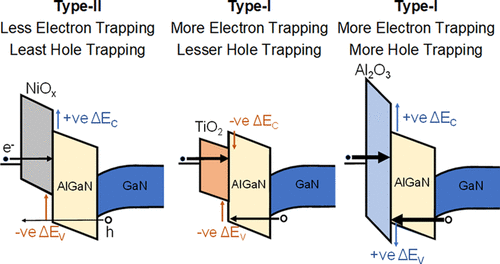当前位置:
X-MOL 学术
›
ACS Appl. Electron. Mater.
›
论文详情
Our official English website, www.x-mol.net, welcomes your feedback! (Note: you will need to create a separate account there.)
Off-State Degradation and Recovery in Oxide/AlGaN/GaN Heterointerfaces: Importance of Band Offset, Electron, and Hole Trapping
ACS Applied Electronic Materials ( IF 4.7 ) Pub Date : 2020-06-23 , DOI: 10.1021/acsaelm.0c00322 Jaya Jha 1 , Mudassar Meer 1 , Swaroop Ganguly 1 , Dipankar Saha 1
ACS Applied Electronic Materials ( IF 4.7 ) Pub Date : 2020-06-23 , DOI: 10.1021/acsaelm.0c00322 Jaya Jha 1 , Mudassar Meer 1 , Swaroop Ganguly 1 , Dipankar Saha 1
Affiliation

|
The properties of the oxide/AlGaN heterointerface are investigated from field-dependent off-state degradation and recovery in thermally grown NiOx-, TiO2-, and Al2O3-based metal-oxide-semiconductor high electron mobility transistors (MOS-HEMTs). Al- and Ti-oxides form type-I straddling band alignment with positive and negative band offsets, respectively, and Ni-oxide forms type-II staggered band alignment with AlGaN. These oxides show promising results for high-performance HEMTs suitable for switching applications. The oxides are grown by rapid thermal oxidation of a thin film of the respective metals. The properties are quantified from the degradation and recovery of critical device parameters. The oxides largely follow the field-dependent degradation by electron and hole trapping. The critical fields for electron–hole pair generation and dominance of hole trapping over electron trapping have great significances in applied power electronics due to the presence of inherently large voltage transients. In addition to the quality of interfaces, oxide band alignment with AlGaN is important. The degradation and recovery are faster in Al2O3, indicating the presence of shallow traps and type-I band alignment. Even though NiOx shows the highest gate leakage current due to the type-II heterostructure, it shows negligible degradation in most of the parameters. The prestressed TiO2 devices show a performance similar to that of Al2O3 samples. Meanwhile, TiO2 shows the least degradation and endures the largest off-state voltage owing to the better heterointerfacial properties and type-I band alignment with negative band offsets. Both Al2O3 and TiO2 follow the field-dependent degradation due to electron trapping followed by hole trapping, which is concluded from the crossover in the threshold voltage for the formation of two-dimensional electron gas and confirmed by repeating the measurements for various gate-to-drain separated devices. The device breakdown for the applied off-state step stress occurs at 120, 140, and 100 V for NiOx, TiO2, and Al2O3, respectively. The corresponding gate-connected field plate devices show breakdown voltages in an excess of 600 V.
中文翻译:

氧化物/ AlGaN / GaN异质界面中的失态降解和恢复:带隙,电子和空穴俘获的重要性
通过在热生长的NiO x-,TiO 2-和Al 2 O 3中场依赖的场态降解和恢复来研究氧化物/ AlGaN异质界面的特性的金属氧化物半导体高电子迁移率晶体管(MOS-HEMT)。铝氧化物和钛氧化物分别形成具有正和负能带偏移的I型跨谱带取向,而镍氧化物与AlGaN形成II型交错带谱。这些氧化物显示出适用于开关应用的高性能HEMT的前景广阔。通过快速热氧化各个金属的薄膜来生长氧化物。从关键设备参数的退化和恢复中量化性能。氧化物在很大程度上取决于电子和空穴俘获的场依赖性降解。由于固有的大电压瞬变的存在,对于电子-空穴对的产生和在电子俘获中的空穴俘获占优势的临界场在应用功率电子学中具有重要意义。除了界面质量外,AlGaN的氧化物带取向也很重要。铝的降解和恢复更快2 O 3,表明存在浅陷阱和I型能带对准。尽管由于II型异质结构,NiO x显示出最高的栅极泄漏电流,但在大多数参数中其表现出的退化却可以忽略不计。预应力TiO 2器件的性能类似于Al 2 O 3样品。同时,由于更好的异质界面性能和具有负能带偏移的I型能带排列,TiO 2表现出最少的降解,并能承受最大的断态电压。Al 2 O 3和TiO 2两者跟随由于电子俘获和空穴俘获而引起的场相关退化,这是由形成二维电子气的阈值电压的交叉得出的结论,并通过对各种栅漏分离器件重复测量而得到证实。对于NiO x,TiO 2和Al 2 O 3,在施加的断态阶跃应力下器件击穿分别发生在120、140和100 V下。相应的栅极连接的场板器件显示的击穿电压超过600V。
更新日期:2020-07-28
中文翻译:

氧化物/ AlGaN / GaN异质界面中的失态降解和恢复:带隙,电子和空穴俘获的重要性
通过在热生长的NiO x-,TiO 2-和Al 2 O 3中场依赖的场态降解和恢复来研究氧化物/ AlGaN异质界面的特性的金属氧化物半导体高电子迁移率晶体管(MOS-HEMT)。铝氧化物和钛氧化物分别形成具有正和负能带偏移的I型跨谱带取向,而镍氧化物与AlGaN形成II型交错带谱。这些氧化物显示出适用于开关应用的高性能HEMT的前景广阔。通过快速热氧化各个金属的薄膜来生长氧化物。从关键设备参数的退化和恢复中量化性能。氧化物在很大程度上取决于电子和空穴俘获的场依赖性降解。由于固有的大电压瞬变的存在,对于电子-空穴对的产生和在电子俘获中的空穴俘获占优势的临界场在应用功率电子学中具有重要意义。除了界面质量外,AlGaN的氧化物带取向也很重要。铝的降解和恢复更快2 O 3,表明存在浅陷阱和I型能带对准。尽管由于II型异质结构,NiO x显示出最高的栅极泄漏电流,但在大多数参数中其表现出的退化却可以忽略不计。预应力TiO 2器件的性能类似于Al 2 O 3样品。同时,由于更好的异质界面性能和具有负能带偏移的I型能带排列,TiO 2表现出最少的降解,并能承受最大的断态电压。Al 2 O 3和TiO 2两者跟随由于电子俘获和空穴俘获而引起的场相关退化,这是由形成二维电子气的阈值电压的交叉得出的结论,并通过对各种栅漏分离器件重复测量而得到证实。对于NiO x,TiO 2和Al 2 O 3,在施加的断态阶跃应力下器件击穿分别发生在120、140和100 V下。相应的栅极连接的场板器件显示的击穿电压超过600V。



























 京公网安备 11010802027423号
京公网安备 11010802027423号